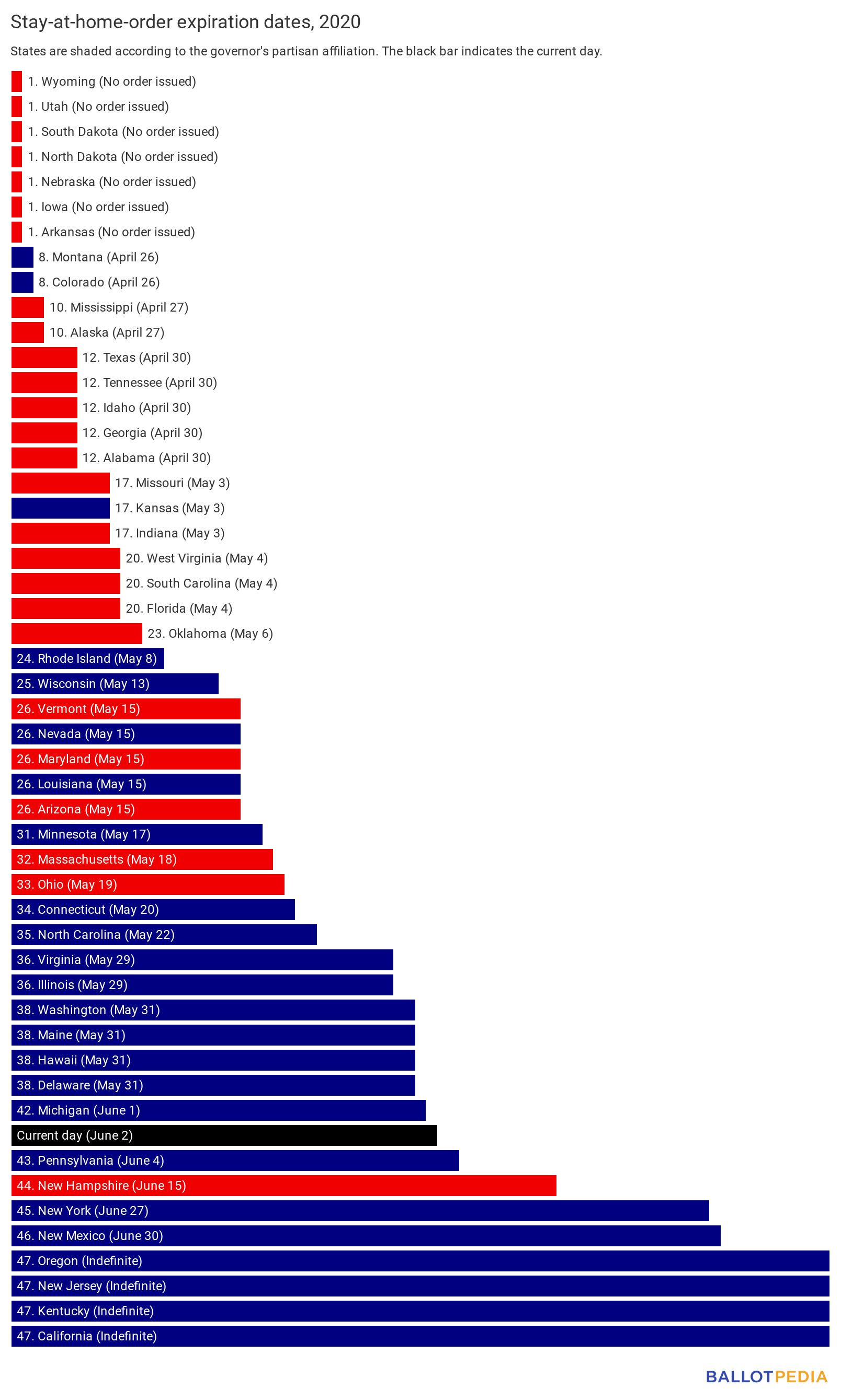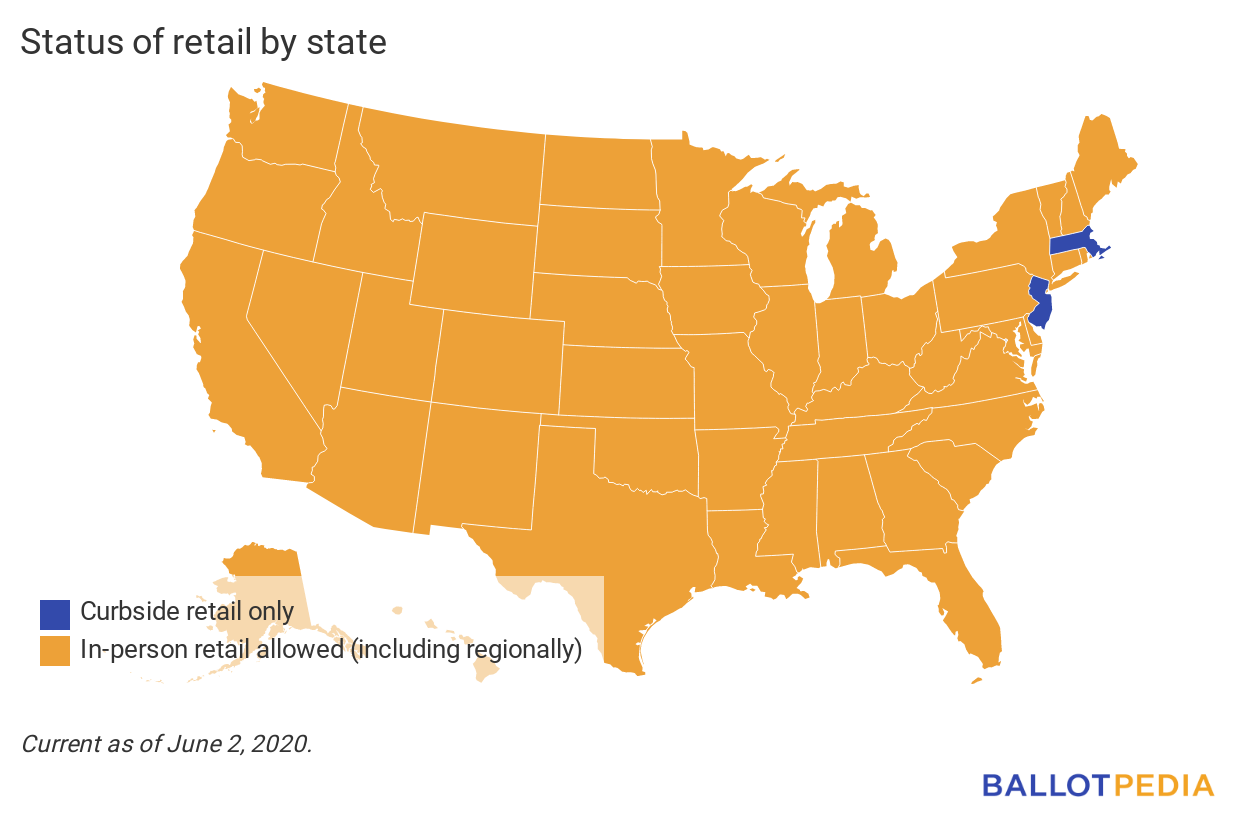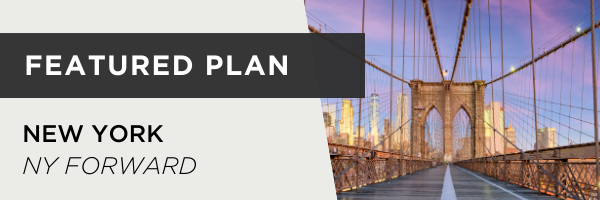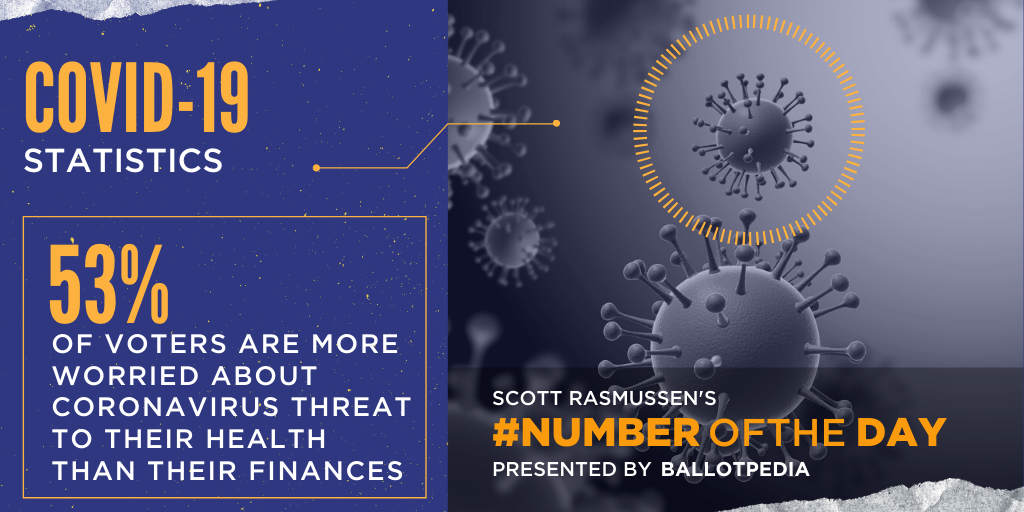Each day, we:
- Track the status of reopening in all 50 states.
- Compare the status of one industry or activity across the country.
- Provide in-depth summaries of the latest reopening plans.
- Give you the latest stories on other reopening plans and ideas.
Want to know what happened yesterday? Click here.
We’re covering elections for 1,011 offices in 12 states and Washington, D.C. on June 2. Here’s how you can follow the results.
- View election results on Ballotpedia.
- Subscribe to The Heart of the Primaries and receive key primary results in your inbox.
- Register for our free results webinar, happening June 4 at noon eastern.
The next two days
What is reopening in the next two days? Which stay-at-home orders will expire?
June 3
- New York (Democratic trifecta): On June 1, Gov. Andrew Cuomo (D) announced that the Capital region is expected to enter Phase 2 of Cuomo’s reopening plan “NY Forward” on June 3. Western New York entered Phase 2 on June 2. Read more about New York’s reopening in today’s Featured Plan.
June 4
- Michigan (divided government): On June 1, Gov. Gretchen Whitmer (D) issued an executive order allowing retail stores to reopen statewide on June 4. For stores with less than 50,000 square feet of customer floor place, capacity will be limited to 25%. For larger stores, the number of customers cannot exceed four per 1,000 square feet of customer floor space. Whitmer also lifted the state’s stay-at-home order effective immediately and moved the entire state into Phase 4 of its reopening plan. The stay-at-home order had been set to expire on June 12.
Since our last edition
Have any states opened? For a continually updated article on reopening status in all 50 states, click here. For our last edition, click here.
- Colorado (Democratic trifecta): Gov. Jared Polis (D) signed an order he called “Safer at Home and in the Vast, Great Outdoors.” The order allows vulnerable Colorado residents to leave their homes for outside recreation as long as they wear face coverings and practice social distancing. The order also allows short-term rentals, playgrounds, and swimming pools to reopen. Personal care services may begin operating at 50% capacity on June 4 and child care facilities can begin operating at full capacity on that date. The order is set to last until July 1.
- Louisiana (divided government): On June 1, Gov. John Bel Edwards (D) announced the state would move into Phase 2 of its reopening plan, effective June 5. In Phase 2, the following businesses will be allowed to reopen at 50% capacity: restaurants and coffee shops; shopping malls; gyms and fitness centers; barbershops and nail salons; movie theaters; racetracks (without spectators); museums, zoos, and aquariums; bars and breweries with food permits; massage and spa businesses; tattoo parlors; esthetician services; pool halls, bowling alleys, and skating rinks; event centers and wedding venues; and outdoor playgrounds and play centers. Phase 2 will last at least 21 days. Edwards said he would sign the executive order formalizing the changes before June 4.
- Maine (Democratic trifecta): Maine entered the second phase of its reopening plan on June 1. The following businesses and activities were allowed to reopen or resume: retail stores; dine-in service at restaurants (outdoor service only in York, Cumberland, and Androscoggin counties); community buildings; day camps and summer recreation programs; state park campgrounds; coastal state parks; community sports; lodging; and tanning salons. The limit on social gatherings was raised from 10 to 50 people.
- Massachusetts (divided government): On June 1, Gov. Charlie Baker (R) issued an executive order outlining which businesses would be permitted to reopen in phases 2, 3, and 4 of the state’s reopening plan. Although Baker did not fix a date for the start of Phase 2, he authorized businesses to allow employees to return to work in preparation for Phase 2. In Phase 2, the following businesses will be allowed to reopen: retail stores; restaurants; hotels, motels, and other lodging; amateur sports programs; professional sports practice and training programs; personal services; non-athletic instructional classes for youths; driving and flight schools; outdoor historical spaces; funeral homes; warehouses and distribution centers; golf facilities; outdoor recreation facilities; post-secondary schools; day camps; and public libraries.
- New Hampshire (divided government): As part of Gov. Chris Sununu’s (R) “Stay-at-Home 2.0” order, the following businesses and activities were permitted to resume on June 1: gyms and fitness centers (50% occupancy), personal services such as nail salons (50% occupancy), and some beaches (for transitory activities like walking and running only).
- West Virginia (Republican trifecta): At a press conference on June 1, Gov. Jim Justice (R) announced the state had entered Week 6 of the reopening plan and the outlined next steps. More businesses, like casinos and movie theaters, will reopen on June 5.
- Hawaii (Democratic trifecta): Gov. David Ige (D) announced the 14-day self-quarantine requirement for inter-island travelers will be lifted starting June 16. Restrictions on out-of-state travel will remain in effect.
Update on stay-at-home orders
Forty-three states issued orders directing residents to stay home except for essential activities and the closure or curtailment of businesses each state deemed nonessential. Seven states did not.
As of June 2, stay-at-home orders have ended in 35 states. Eighteen of those states have Republican governors and 17 have Democratic governors (including Wisconsin, where the state Supreme Court invalidated the stay-at-home order). Of the eight states with active stay-at-home orders, seven have Democratic governors and one has a Republican governor.
Here’s which stay-at-home orders have expired, and when the rest are scheduled to expire.

Tracking regulations: Retail
All 50 states began to reopen in some way. Here, we give the status of one industry or activity across the states. Today’s question: in which states are retail shops open to customers, and in which states are they limited to curbside or delivery service?
Retail shops are open to customers (in at least some regions) in 48 states. New Jersey and Massachusetts allow curbside or delivery only.
- Massachusetts (divided government): Retail businesses were allowed to reopen with remote ordering and curbside delivery services beginning May 25. Each phase of reopening in Massachusetts is expected to last for three weeks, so the status of retail in the state could change on June 15.
- New Jersey (Democratic trifecta): Retail businesses were allowed to reopen for curbside pickup and delivery services beginning May 18. Gov. Phil Murphy (D) has already announced that retail businesses will be allowed to reopen to in-store customers with limited capacity on June 15.


This is an in-depth summary of one of the latest reopening plans. Is there a plan you’d like us to feature? Reply to this email and let us know. Click a state below to read a previous Featured Plan.
Previous featured plans
On April 26, New York Gov. Andrew Cuomo (D) unveiled a reopening plan for the state, under which businesses would be allowed to reopen or resume operations on a phased, regional basis. Once a region has recorded 14 days of declining hospitalizations, it can begin reopening. Each phase would last at least two weeks, allowing officials to monitor the effects of reopening on hospitalization and infection rates.
Cuomo said the first phase of reopening would include construction and manufacturing companies with low risks of workplace infection. Subsequent phases would allow more businesses to reopen, with lower-risk businesses given priority.
On May 4, Cuomo released further guidelines on New York’s phased reopening. He identified seven criteria for determining whether a region could begin reopening:
- A region must experience a 14-day decline in total net hospitalizations on a three-day rolling average. Alternatively, a region with relatively few COVID-19 cases cannot exceed 15 net new hospitalizations on a three-day rolling average.
- A region must experience a 14-day decline in deaths on a three-day rolling average. If a region has relatively few COVID-19 cases, it must see five or fewer new deaths on a three-day rolling average.
- A region must have fewer than two new COVID-19 patients admitted to hospitals per 100,000 residents per day on a three-day rolling average.
- A region must have at least 30% of its total hospital beds available.
- A region must have at least 30% of its ICU beds available.
- A region must have the capacity to run 30 diagnostic tests for every 1,000 residents per month.
- A region must have a baseline of 30 contact tracers for every 100,000 residents.
Cuomo said, “Rather than starting and stopping, you’d rather have a controlled start, so you don’t have to stop, right? And that’s what you learn from the other countries. You reopen too fast, then you have to stop, and nobody wants to have gone through all of this and then start just to stop again. Well, how does that happen? First of all, it’s not going to happen statewide. This state has different regions which are in much different situations than other regions in this state. And rather than wait for the whole state to be ready, reopen on a regional basis. If upstate has to wait for downstate to be ready, they’re going to be waiting a long time.”
For the purposes of the reopening plan, New York is divided into the following regions. As of June 1, all regions but New York City had met all seven of the reopening criteria. To access a map of the state’s regions, click here.
- Capital Region
- Central New York
- Finger Lakes
- Long Island
- Mid-Hudson
- Mohawk Valley
- New York City
- North Country
- Southern Tier
- Western New York
Context
- On March 20, Cuomo issued New York’s initial statewide stay-at-home order. It did not have a fixed expiration date. On April 16, he extended the order through May 15. Cuomo subsequently further extended the order in those regions that haven’t met the reopening criteria, first through June 13, and then through June 27.
- As of June 1, New York had 371,711 confirmed COVID-19 cases and 23,959 related fatalities. New York’s estimated population as of July 2019 was 19.5 million. For every 100,000 residents, the state had 1,910.8 confirmed cases and 123.2 fatalities.
- New York is a Democratic trifecta, with a Democratic governor and Democratic majorities in both chambers of the state legislature.
Plan details
General guidelines for individuals
Individuals are required to wear face coverings when they are in public and within six feet of others. Individuals must also wear face coverings in any public or private transportation carrier or for-hire vehicle.
Effective May 21, religious gatherings of up to 10 people were permitted statewide. Drive-in and parking-lot services were also allowed effective May 21.
Phase 1
The following businesses are allowed to reopen during Phase 1 (click an industry name for detailed guidelines):
The following regions have been cleared for Phase 1:
- Capital Region (effective May 20)
- Central New York (effective May 15)
- Finger Lakes (effective May 15)
- Long Island (effective May 27)
- Mid-Hudson (effective May 26)
- Mohawk Valley (effective May 15)
- North Country (effective May 15)
- Southern Tier (effective May 15)
- Western New York (effective May 19)
Phase 2
The following businesses are allowed to reopen during Phase 2, all at 50% occupancy (click an industry name for detailed guidelines):
The following regions have been cleared for Phase 2:
- Capital Region (expected to enter Phase 2 on June 3)
- Central New York (effective May 29)
- Finger Lakes (effective May 29)
- Mohawk Valley (effective May 29)
- North Country (effective May 29)
- Southern Tier (effective May 29)
- Western New York (effective June 2)
Phase 3
The state has not released industry-specific guidelines for Phase 3 reopening. No region has been cleared for Phase 3 reopening.
Phase 4
The state has not released industry-specific guidelines for Phase 4 reopening. No region has been cleared for Phase 4 reopening.
New York City
On May 29, Cuomo announced that New York City was expected to enter Phase 1 on June 8.
Reactions
- Tioga County Legislature Chairwoman Martha Sauerbrey said, “I think it’s a mixed bag of emotions, because I do hear from people who are fearful and cautious, and I know businesses need to open and want to open, but we want them to be careful. There’s no covering up the fact that this has been challenging, so we have to do everything we can to get them back up and running.”
- Denis Nash, an epidemiologist, said the following at the time of Cuomo’s May 4 reopening announcement: “So, right now, New York has been, I think, pretty successful at reducing community transmission through the stay at home order. By the time it’s lifted, it should be very, very low. And so we’re kind of back to a place where we were early on in the epidemic and then a testing and a contact-tracing strategy becomes more feasible.”
- On May 29, Nick Langworthy, chairman of the Republican Party of New York, issued a statement opposing Cuomo’s decision not to advance some regions to Phase 2: “It’s time for Andrew Cuomo to stop playing games with people’s livelihoods. The Governor’s capricious, arbitrary and punitive behavior has gone too far. These regions worked incredibly hard to meet the metrics he laid out and changing the goal posts at the 11th hour is unacceptable. We don’t need a group of international so-called experts or a power-hungry governor dictating our freedoms. Enough is enough.”
- Rensselaer County Executive Steve McLaughlin said, “If we’ve got to test 30 per 1,000 residents, that’s 4,800 Rensselaer County residents every single month. Quite honestly, I don’t think the demand is there. I mean, am I supposed to test the same people over and over again? If he requires hospitals to stay 30 percent empty, there’s not a hospital that I know of that will not go bankrupt this year. At our peak in Rensselaer County there were 20 people hospitalized. I currently have six, one in the ICU, and our economy is at a complete standstill.”
|





